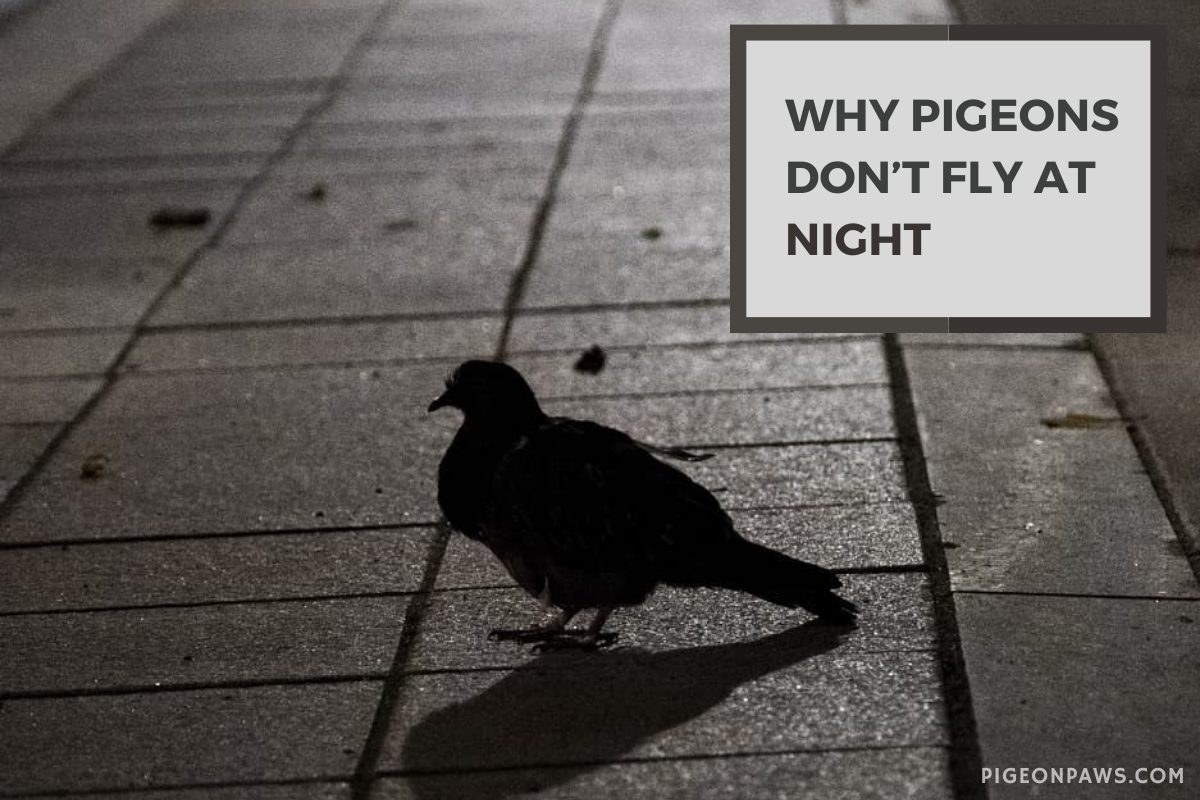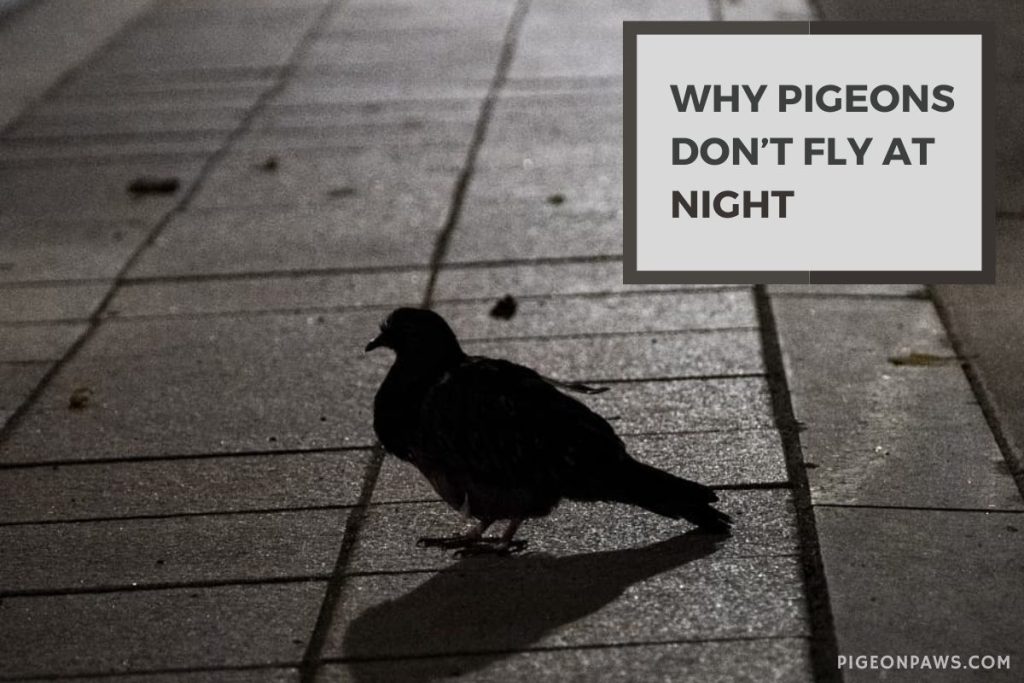Why Pigeons Don’t Fly at Night? Explained!

Imagine a warm summer night; you’re lying in bed, trying to fall asleep. Suddenly, you hear a fluttering sound coming from your window. You look outside to find a pigeon flying aimlessly, dodging trees and buildings.
You can’t help but wonder, why don’t pigeons fly at night? It’s a common question and one that has a surprisingly complex answer.
Pigeons, like many birds, suffer from physical and biological disadvantages that make flying in the dark difficult, such as limited night vision. In addition, evolutionary and behavioral elements are likely contributors.
Suppose you are interested in the reasons why pigeons avoid night-time flights. In that case, this article will provide insight into the explanation of the reasons, sensory cues pigeons use to navigate, and much more. So keep reading!

Let’s Explore the Possible Reasons Why Pigeons Refrain from Flying at Night!
Now, I’m going to be talking to you about the fascinating explanation behind why pigeons don’t fly at night. As you may know, they are known as day birds, meaning they’re active during the day and sleep at night. But why is that?? As it turns out, there are several factors that play a role in this phenomenon.
Physical Limitations
These birds are not equipped with the same type of night vision as nocturnal animals such as owls. This makes it difficult for them to see obstacles in the dark and navigate successfully. Besides, they have a limited ability to fly in low-light conditions, making it harder for them to fly at night.
Biological Limitations
Another factor to consider is the biological limitations of pigeons. These birds have a unique circadian rhythm that influences their behavior, including their sleep patterns.
Pigeons are diurnal birds, meaning they are active during the day and rest at night. This pattern of activity is hardwired into their biology, and it affects their ability to fly at night.
Survival
Pigeons, like all animals, are driven by the desire to survive. Flying at night presents a number of challenges, such as navigating in the dark and avoiding obstacles. By avoiding night-time flight, pigeons reduce their risk of injury or death. This helps to ensure their survival and propagate their species.
Natural Selection
Over time, this avoidance of night-time flight has been shaped by natural selection. Pigeons better adapted to diurnal patterns and were more likely to survive and reproduce.
As a result, the traits that made them well-suited to diurnal activity were passed down to future generations. This process of natural selection has resulted in pigeons becoming diurnal birds that rest at night.
How Do Other Birds Manage to Fly at Night?
It is a known fact that certain bird species are capable of flying during nighttime. It is interesting to understand the mechanics behind their ability to fly in the dark. Pigeons do not have these mechanisms that’s why they can’t fly at night. Let’s explore this topic further.
Adaptations for Night Vision
Nocturnal birds have adaptations that allow them to see in low-light conditions. For example, many species of nocturnal birds have large eyes capable of collecting more light, like nightjars, owls, and bats. This helps them to see at night and avoid obstacles while flying.
Silent Feathers
Another adaptation that helps nocturnal birds fly at night is their silent feathers. These feathers are specially designed to reduce the sound they make when they fly, which helps them to fly quietly and avoid being detected by predators.
Navigation
Along with these adaptations, nocturnal birds have developed specialized navigation skills that allow them to fly at night. For example, they use the stars and other celestial objects to navigate and find their way.
Pigeons Do Not Posses These Abilities
While some animals have remarkable abilities to navigate and protect themselves in the dark, pigeons do not possess these same skills. Unlike other creatures, they do not have the capacity to confidently hunt or travel in complete darkness.
These birds are more adapted to the human timetable and rely on artificial light to guide them at night. Therefore, they may not be as equipped to handle the challenges of navigating in the dark as other species.
What Are the Risks of Pigeons Flying at Night?
Have you ever wondered what the risks are of pigeons flying at night? Well, you’re not alone! A lot of people have no idea what kind of risks the birds take when they take to the skies after dark.
Disorientation
Disorientation is one of the most severe risks of pigeons flying at night. Pigeons navigate and find their way using the sun and other environmental cues. They can become disoriented and fly in the wrong direction if they don’t have these cues, which can lead to exhaustion, injury, or even death.
Predators
Nocturnal predators, such as owls, are more active at night and pose a significant threat to pigeons. Without the ability to see well in the dark, they are disadvantaged and more likely to be caught by predators.
Collisions
Flying at night can also increase the risk of collisions with buildings, power lines, and other objects. Pigeons are more likely to fly into obstacles in low light conditions, which can cause injury or death.
What Triggers Pigeons to Fly at Night?
Despite being a species that is active during the day, there are certain circumstances that can trigger pigeons to fly at night. The following factors can cause pigeons to fly at night:
- Loud, sudden noises: Pigeons can be scared and triggered by loud, sudden noises, such as those associated with building construction.
- Lights left on late at night: The presence of lights, especially those near trees, can also cause pigeons to fly at night.
- Outdoor parties or gatherings: Large outdoor events with a lot of noise can also scare pigeons and cause them to fly at night.
- Protection from predators: In the case of a predator nearby, pigeons may fly out of their roosting spots to protect themselves and others from danger.
Is the Lack of Fear Towards Humans the Reason Pigeons Don’t Fly at Night?
The lack of fear towards humans is one of the main reasons why pigeons are unafraid. This fearlessness often extends to nighttime, when pigeons typically roost rather than fly.
Do Pigeons Avoid Trees Because They Don’t Fly at Night?
Do pigeons avoid trees for reasons pigeons avoid trees? It’s often said that pigeons don’t fly at night, and this might be the motivation behind their avoidance of trees. By roosting on tall buildings and structures, pigeons may have evolved to prioritize safety and warmth over the potential dangers of perching on trees during the dark hours.
What Are Some Ways to Help Pigeons Fly at Night?
While pigeons have evolved to avoid night-time flight, there are ways to help them fly at night if necessary. You can take a look at some of these methods.
Artificial Lighting
One way to help pigeons fly at night is by providing artificial lighting. This can help to illuminate their path and reduce the risk of collisions with obstacles. Artificial lighting can also help pigeons to navigate and find their way.
Lighting Attachments
You can consider attaching lighting devices to their bodies. These devices emit a soft light that can help pigeons to see and avoid obstacles while flying. This method can also help to reduce the risk of predation, as predators are less likely to see the light and attack the pigeon.
Guided Flight
This can be done using a laser pointer or other guiding device to show them the way. This method can be especially useful in emergencies, where pigeons must fly at night to avoid danger or reach safety.
Conclusion
The question of why pigeons don’t fly at night is complex and has biological and physical explanations. Pigeons have evolved to avoid night-time flight due to the risks posed by disorientation, predation, and collisions.
However, with the help of artificial lighting, lighting attachments, and guided flight, it is possible to help pigeons fly at night if necessary. It’s fascinating to learn about the unique adaptations and behaviors of pigeons and other animals.
By understanding why pigeons don’t fly at night, we can gain a deeper appreciation for the incredible abilities of these fascinating birds and the challenges they face in their daily lives.

